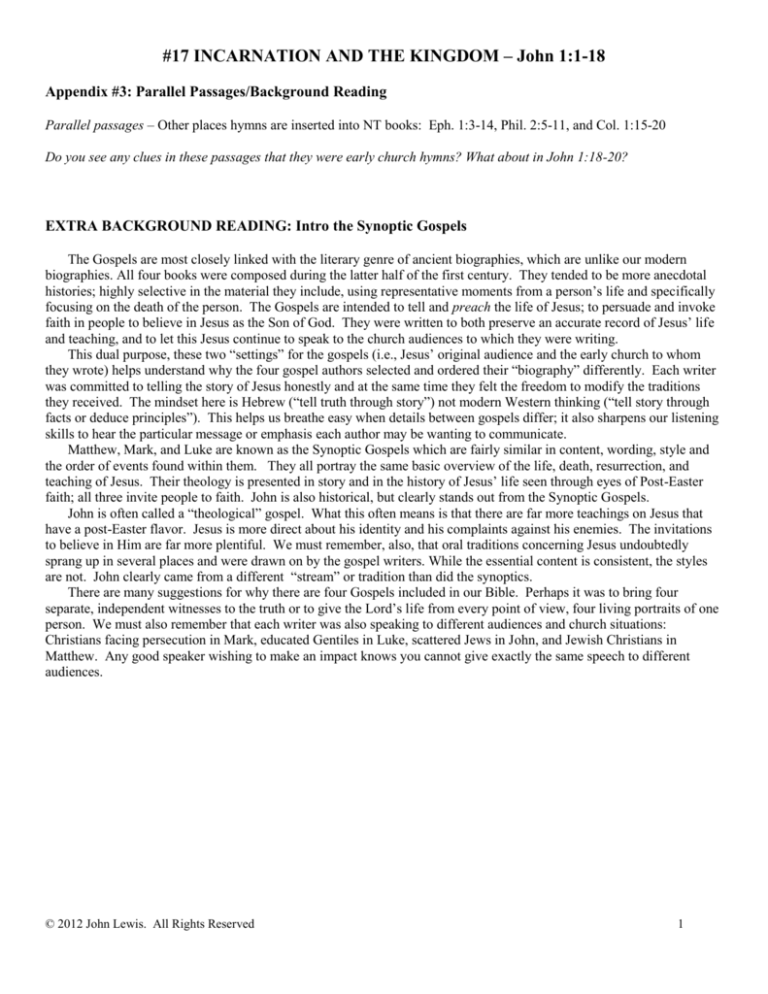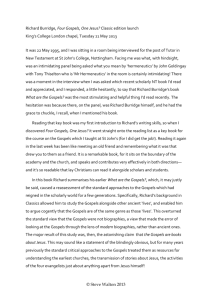
#17 INCARNATION AND THE KINGDOM – John 1:1-18
Appendix #3: Parallel Passages/Background Reading
Parallel passages – Other places hymns are inserted into NT books: Eph. 1:3-14, Phil. 2:5-11, and Col. 1:15-20
Do you see any clues in these passages that they were early church hymns? What about in John 1:18-20?
EXTRA BACKGROUND READING: Intro the Synoptic Gospels
The Gospels are most closely linked with the literary genre of ancient biographies, which are unlike our modern
biographies. All four books were composed during the latter half of the first century. They tended to be more anecdotal
histories; highly selective in the material they include, using representative moments from a person’s life and specifically
focusing on the death of the person. The Gospels are intended to tell and preach the life of Jesus; to persuade and invoke
faith in people to believe in Jesus as the Son of God. They were written to both preserve an accurate record of Jesus’ life
and teaching, and to let this Jesus continue to speak to the church audiences to which they were writing.
This dual purpose, these two “settings” for the gospels (i.e., Jesus’ original audience and the early church to whom
they wrote) helps understand why the four gospel authors selected and ordered their “biography” differently. Each writer
was committed to telling the story of Jesus honestly and at the same time they felt the freedom to modify the traditions
they received. The mindset here is Hebrew (“tell truth through story”) not modern Western thinking (“tell story through
facts or deduce principles”). This helps us breathe easy when details between gospels differ; it also sharpens our listening
skills to hear the particular message or emphasis each author may be wanting to communicate.
Matthew, Mark, and Luke are known as the Synoptic Gospels which are fairly similar in content, wording, style and
the order of events found within them. They all portray the same basic overview of the life, death, resurrection, and
teaching of Jesus. Their theology is presented in story and in the history of Jesus’ life seen through eyes of Post-Easter
faith; all three invite people to faith. John is also historical, but clearly stands out from the Synoptic Gospels.
John is often called a “theological” gospel. What this often means is that there are far more teachings on Jesus that
have a post-Easter flavor. Jesus is more direct about his identity and his complaints against his enemies. The invitations
to believe in Him are far more plentiful. We must remember, also, that oral traditions concerning Jesus undoubtedly
sprang up in several places and were drawn on by the gospel writers. While the essential content is consistent, the styles
are not. John clearly came from a different “stream” or tradition than did the synoptics.
There are many suggestions for why there are four Gospels included in our Bible. Perhaps it was to bring four
separate, independent witnesses to the truth or to give the Lord’s life from every point of view, four living portraits of one
person. We must also remember that each writer was also speaking to different audiences and church situations:
Christians facing persecution in Mark, educated Gentiles in Luke, scattered Jews in John, and Jewish Christians in
Matthew. Any good speaker wishing to make an impact knows you cannot give exactly the same speech to different
audiences.
© 2012 John Lewis. All Rights Reserved
1
HISTORICAL BACKGROUND to the GREEKS/GNOSTICSAND RELEVANCE TODAY
John is writing to a Greek audience that includes both Jews and Gentiles, some of whom practice Gnosticism. What
are some of the things Greek Gnostics/Hellenists (influenced by Plato) believed about flesh and spirit, about knowing
God and the nature of religion?
Now read the two quotes at the bottom of the page.
Think of several issues that we face as followers of Jesus that have no easy answer or clearly involve two seeming
opposites (a divine and human side usually). E.g. Free will and predestination.
1.
2.
3.
Let’s consider how the incarnation and human/divine paradox of Jesus helps us approach one of these issues.
Quote on Tension in Theology:
All spirituality – but especially a spirituality of imperfection – involves the perceiving, embracing, and living out of
paradox. A “paradox” is an apparent contradiction: Two things seem to exclude each other, but in truth need not do
so. “Square circle” is a contradiction; “saintly sinner” is a paradox, as is “holy fool,” an incongruity especially
cherished in the Russian Christian tradition. Openness to paradox allows both the understanding and the acceptance
of our human condition as “both/and” (both a saint and sinner) rather than “either-or”(either a saint or a sinner). The
demand for “either-or, for one-or-the other, signals the rejection of paradox and therefore the denial of spirituality…
Having split our world (and our selves) into either-or dualisms – god or beast, angel or devil, right or wrong, left or
right, good or evil up or down – we lack all sense of balance. We tend to sway precariously on the teeter-totter of life,
running from one extreme to the other, missing the point that the only stable place to be is in the mixed-up middle. In
reality, that is the only place we can be.
Ernest Kurtz, The Spirituality of Imperfection
© 2012 John Lewis. All Rights Reserved
2











